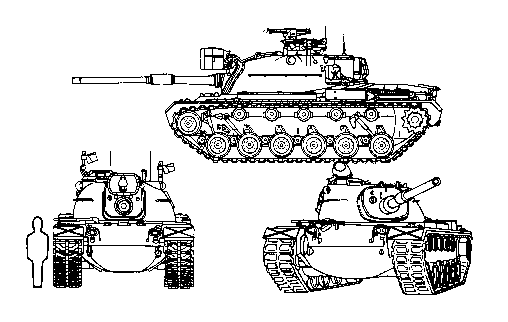
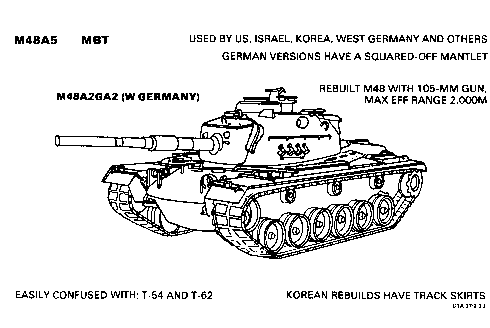

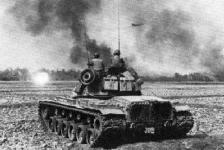
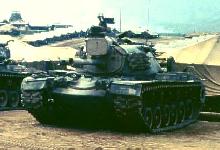
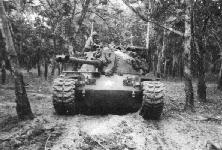
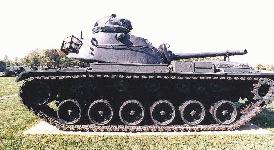




Developed from the M47 "General Patton" tank, the M48 was the mainstay of the US Army and Marines in Vietnam. Some 11,703 M48s were built between 1952 and 1959. Originally they had 90mm guns, but upon moficiation to the M48A5 standard they were given the British 105mm. The M48 was withdrawn from American service in favor of the M60, a further development of the M48, but the M48 Patton remains in service in a number of armies around the world.
The M48-A2C featured a gasoline engine which was very prone to fire. This model was replaced in 1968 by the M48-A3 powered by a diesel unit. In the 1970's development of the AVDS 1790 2C/2D series of engines, rated at 750 Horsepower, were utilized in the M60A3, Retrofited AMX-30 Tank, Modernized Centurion Tank, M88A1, Retrofited M47, and Modernized M48A5 Tank. In the 1980's the AVDS 1790 Red Seal Engines, rated at 750 Horsepower were used on the Upgraded M48A5 and the Upgraded M60A3 Tanks. In the 1990'S, the AVDS Gold Medallion Engine, producing 750 Horsepower was produced and used in the upgraded M48A5 Tank.The M48 vehicle is separated into three compartments: the driver's compartment, the fighting compartment where the Gunner, Loader, and Tank Commander [TC] fought, and the engine compartment. Above the main gun was a 1 million candle-power Xenon searchlight. This light had both a white light and an infrared mode. It was boresighted with the main gun and gunsights so that it could be used to illuminate a target at night.
The M48 was been designed for combat in Europe against Soviet tanks. When first deployed, the M48-A3 had for the 1960s a state-of-the-art fire control system. At the time computers were mechanical, and range to the target was provided by a stereoscopic range finder, which functioned similarly to a 35mm camera. An end-box on each side of the turret exterior held a prism-type mirror. Turning a hand-crank on the range finder would pivot these mirrors until the double-image in the range finder merged. As the distance between the mirrors is exactly known, a little trigonometry provided the range (in meters) to the target. This information was displayed on a range indicator, and also fed to the ballistic computer by a rotating shaft. The ballistic computer was a collection of gears and cams--nothing was solid-state--which had a handle so that the gunner could select the type of ammunition that was to be fired. Each round had a different muzzle velocity, and therefore the computer had a different cam for each type. The computer would take the range data, merge it with the velocity data, and via a set of rotating shafts, supply this information to the gun's super-elevation mechanism, resulting in the gun being elevated above the gunners line of sight sufficiently for the round to overcome the downward pull of gravity on its way to the target. The gunner's sight however remained locked onto the target.
A good crew in Europe was able to put the first round on target 90% of the time, but this required excellent teamwork and communication on the part of the entire crew. In peacetime qualification, it was possible to stop from a speed of 20 mph, acquire the target, and get off a first round kill at 2,000 yards in seven seconds. This precision fire control system was almost irrelevant in Vietnam where typical engagement ranges could be measured more reasonably in feet than in yards. So in Vietnam it was common to take the gunner out of the turret and put him on the back deck with an M16 or M79 for close-in protection. This also afforded him some protection from mines, and indeed the tank commander and loader often rode on the turret roof or the hatch lips when mines were expected. The TC laid the main gun by eye, and fired using the commander's override control or a lanyard to the manual trigger on the main gun. Most M48's in Vietnam had the commander's .50 cal. mounted on top of the cupola on a simple pintle mount. This location gave a better field of fire, was faster to reload, and less prone to jamming than when the M2 was placed on its side inside the armored cupola. But the TC was terribly exposed to fire when firing the M2.
Rocket Propelled Grenades were a constant threat in Vietnam, and M48 tanks countered this threat by mounting Pierced Steel Plank, chain link fence, and spare track blocks on the fenders to prematurely detonate incoming RPG's. The bustle rack was extended with welded steel, and the turret sides buttressed with extra .50 cal. ammo, C-ration cases, and the crew's duffel bags. The cases of C-rations strapped to the infantry rail on the turret, like the PSP and track blocks, acted as a stand-off shield. If an enemy anti-tank rocket struck the C-rations, it would explode prematurely. Since anti-tank rounds require a certain stand-off distance to function effectively, the C-rations dissipated the force of the explosion away from the armor. It was also the only place to store the rations, since space in the vehicle was at a premium and occupied mostly by ammunition.
Canister and HE were the primary main gun ammunition types used in Vietnam. Beehive was effective, but usually in short supply. WP was useful, but dangerous to carry since it ignited if split open by a mine or RPG strike, so crews tended to expend it as soon as possible. HEAT briefly was popular after NVA tanks were engaged at Bien Het, but HE was usually preferred against bunkers.
Variants
- M48A5K South Korean variant with 105mm, improved FC system, and considered more capable than early M60s.
- M48A5E Spanish variant with 105mm, laser rangefinder.
- M48A5T1 is a Turkish upgrade, similar to M48A5, the T2 variant includes a thermal sight.
- CM11 Taiwan variant with a modified M48H turrets mated to M60 hulls. An advanced fire control system includes a ballistics computer and stabilized sights with thermal imaging [similar to the US M1 Abrams tank] slaved to the 105mm gun, providing improved target tracking on the move.
- CM12 Taiwan variant mates the CM11 turret to existing M48A3 hulls.
- AVLB variant used by Israel and Taiwan.
- M67 flamethrower featured a shorter, thicker barrel than the normal 90mm armed version.
Specifications | ||
| Dimensions | Hull length | 21ft, with gun forward 30ft 6 in |
| Width | 11ft 11in | |
| Height | 10ft 1 in | |
| Ground Clearance | 16 in | |
| Track Width | 28 in | |
| Weights: | Total | 52 tons
107,997 lbs [M48A5] |
| Hull | 20 tons | |
| Turret | 18 tons | |
| Engine/Transmission | 6 tons | |
| Engine cover | 2 tons | |
| Track | 2 tons each | |
| Basic load | 2 tons | |
| Performance: | ||
| Range | 258 miles / 463 km | |
| Top speed | 40 mph / 48 km/h | |
| Fuel consumption: | 1 g/mi road, 2 g/mi offroad | |
| Fording: | 1.2 m | |
| Vertical Obstacle: | 0 .9 m | |
| Gap Crossing: | 2.59 m | |
| Powerplant: | ||
| Engine | Continental AVDS | |
| 1790 cu in 690 horsepower | ||
| Transmission | Alison CD-850 | |
| Armament: | ||
| Main gun | 90 mm rifled cannon 64 rds 105mm /51 cal M68 rfled gun with 54 rounds [M48A5] | |
| Tank Commander | .50 cal M2 HB machine gun 3000 rds | |
| Coax | 7.62mm M73 machine gun 10,000 rds | |
| Ammunition: | HEAT (High Explosive Anti-Tank) | |
| HEP (High Explosive Plastic) | ||
| Canister | ||
| WP (White Phosphorus) | ||
| Beehive | ||
| Armor: | Homogeneous cast steel | |
| Hull Front | 120 mm | |
| Hull Side, front | 76 mm | |
| Hull Side, rear | 51 mm | |
| Hull rear | 44 mm | |
| Hull floor | 25 mm | |
| Turret Front | 110 mm | |
| Turret Side | 76 mm | |
| Turret Rear | 50 mm | |
| Crew: | 4 (driver, gunner, loader, TC) | |
| Used by | Greece (714 M48A5), Iran, Israel (400 M48A5), Jordan, South Korea (950 M48A5K), :Lebanon (90A1&A5), Morocco (224 M48A5), Norway (38 remaining A5s awaiting disposal), Pakistan (280 M48A5), Portugal(86 M48A5), Spain (164 M48A5E), Taiwain (309 M48A5, 158 M48H), Thailand (100 M48A5), Tunisia, Turkey (578 M48A2C, 179 M48T-5, 1369 M48A5T1, 750 M48A5T2). | |







